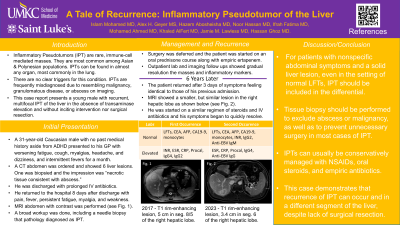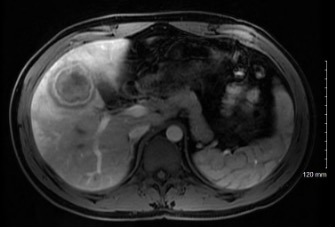Tuesday Poster Session
Category: Liver
P3932 - A Tale of Recurrence: Inflammatory Pseudotumor of the Liver
Tuesday, October 24, 2023
10:30 AM - 4:00 PM PT
Location: Exhibit Hall

Has Audio

Islam Mohamed, MD
University of Missouri-Kansas City
Kansas City, MO
Presenting Author(s)
Islam Mohamed, MD1, Alex Geyer, MS2, Hazem Abosheaishaa, MD3, Noor Hassan, MD1, Ifrah Fatima, MD1, Mohamed Ahmed, MD1, Jamie Lawless, MD4, Laura Alba, MD2, Hassan Ghoz, MD1
1University of Missouri-Kansas City, Kansas City, MO; 2University of Missouri Kansas City, Kansas City, MO; 3Mount Sinai, New York, NY; 4Saint Luke's Hospital, Kansas City, MO
Introduction: Inflammatory pseudotumor (IPT) is a rare condition that can affect a variety of organs including the liver. They are mostly seen in the lung and account for 8% of extrapulmonary IPTs. In this report, we present a young Caucasian male with recurrent and multifocal IPT.
Case Description/Methods: A 31-year-old healthy male presented with right upper quadrant abdominal pain, fever, fatigue, and myalgias that started 5 weeks prior to his presentation. At his primary care office, CT abdomen was ordered that revealed six right hepatic lesions. He was then referred to the hospital for admission. Laboratory results showed mild anemia with monocytosis, normal LFTs, and elevated ESR and CRP. Autoimmune panel and tumor markers were unremarkable. Colonoscopy revealed a benign polyp. Echocardiogram was normal. Empirical treatment for multifocal liver abscesses was started. Biopsy of the liver lesion indicated necrotic tissue consistent with an abscess. Following a 3-day hospitalization, the patient was discharged on Intravenous antibiotics.
Eight days later, the patient returned to the emergency department with persistent symptoms. MRI abdomen showed a persistent mass measuring 5.1 x 4.7 cm in segments 5/8 of the right hepatic lobe. A repeat liver biopsy showed a picture of IPT of the liver. The patient was started on steroids in addition to antibiotics. The IPT ultimately resolved on imaging three years later.
Six years after, the patient experienced a recurrence of his symptoms. MRI abdomen showed a 3.5 cm mass in segment 6 of the liver with fibrosis in his prior large IPT location. The patient was discharged with a prednisone taper and a 1-week course of amoxicillin-clavulanate. One month after, the patient reported feeling well and his laboratory work was unremarkable.
Discussion: When evaluating patients with nonspecific symptoms and a solid liver lesion, IPT should be considered in the differential diagnosis, particularly in the presence of laboratory evidence of an inflammatory process. FNA should be performed to exclude abscesses or malignancy and prevent unnecessary surgery in the case of IPT. After a biopsy-confirmed diagnosis, IPT can be managed conservatively, including with oral steroids and antibiotics. Patients with IPT should receive outpatient follow-up with clinical examination and repeat imaging to ensure complete resolution. In the case of recurrence, IPT should be considered as a possibility for patients with a previous diagnosis presenting with similar symptoms.

Disclosures:
Islam Mohamed, MD1, Alex Geyer, MS2, Hazem Abosheaishaa, MD3, Noor Hassan, MD1, Ifrah Fatima, MD1, Mohamed Ahmed, MD1, Jamie Lawless, MD4, Laura Alba, MD2, Hassan Ghoz, MD1. P3932 - A Tale of Recurrence: Inflammatory Pseudotumor of the Liver, ACG 2023 Annual Scientific Meeting Abstracts. Vancouver, BC, Canada: American College of Gastroenterology.
1University of Missouri-Kansas City, Kansas City, MO; 2University of Missouri Kansas City, Kansas City, MO; 3Mount Sinai, New York, NY; 4Saint Luke's Hospital, Kansas City, MO
Introduction: Inflammatory pseudotumor (IPT) is a rare condition that can affect a variety of organs including the liver. They are mostly seen in the lung and account for 8% of extrapulmonary IPTs. In this report, we present a young Caucasian male with recurrent and multifocal IPT.
Case Description/Methods: A 31-year-old healthy male presented with right upper quadrant abdominal pain, fever, fatigue, and myalgias that started 5 weeks prior to his presentation. At his primary care office, CT abdomen was ordered that revealed six right hepatic lesions. He was then referred to the hospital for admission. Laboratory results showed mild anemia with monocytosis, normal LFTs, and elevated ESR and CRP. Autoimmune panel and tumor markers were unremarkable. Colonoscopy revealed a benign polyp. Echocardiogram was normal. Empirical treatment for multifocal liver abscesses was started. Biopsy of the liver lesion indicated necrotic tissue consistent with an abscess. Following a 3-day hospitalization, the patient was discharged on Intravenous antibiotics.
Eight days later, the patient returned to the emergency department with persistent symptoms. MRI abdomen showed a persistent mass measuring 5.1 x 4.7 cm in segments 5/8 of the right hepatic lobe. A repeat liver biopsy showed a picture of IPT of the liver. The patient was started on steroids in addition to antibiotics. The IPT ultimately resolved on imaging three years later.
Six years after, the patient experienced a recurrence of his symptoms. MRI abdomen showed a 3.5 cm mass in segment 6 of the liver with fibrosis in his prior large IPT location. The patient was discharged with a prednisone taper and a 1-week course of amoxicillin-clavulanate. One month after, the patient reported feeling well and his laboratory work was unremarkable.
Discussion: When evaluating patients with nonspecific symptoms and a solid liver lesion, IPT should be considered in the differential diagnosis, particularly in the presence of laboratory evidence of an inflammatory process. FNA should be performed to exclude abscesses or malignancy and prevent unnecessary surgery in the case of IPT. After a biopsy-confirmed diagnosis, IPT can be managed conservatively, including with oral steroids and antibiotics. Patients with IPT should receive outpatient follow-up with clinical examination and repeat imaging to ensure complete resolution. In the case of recurrence, IPT should be considered as a possibility for patients with a previous diagnosis presenting with similar symptoms.

Figure: Figure 1 displays a rim-enhancing mass measuring 5.1 x 4.7 cm in segments 8/5 of the right hepatic lobe.
Disclosures:
Islam Mohamed indicated no relevant financial relationships.
Alex Geyer indicated no relevant financial relationships.
Hazem Abosheaishaa indicated no relevant financial relationships.
Noor Hassan indicated no relevant financial relationships.
Ifrah Fatima indicated no relevant financial relationships.
Mohamed Ahmed indicated no relevant financial relationships.
Jamie Lawless indicated no relevant financial relationships.
Laura Alba indicated no relevant financial relationships.
Hassan Ghoz indicated no relevant financial relationships.
Islam Mohamed, MD1, Alex Geyer, MS2, Hazem Abosheaishaa, MD3, Noor Hassan, MD1, Ifrah Fatima, MD1, Mohamed Ahmed, MD1, Jamie Lawless, MD4, Laura Alba, MD2, Hassan Ghoz, MD1. P3932 - A Tale of Recurrence: Inflammatory Pseudotumor of the Liver, ACG 2023 Annual Scientific Meeting Abstracts. Vancouver, BC, Canada: American College of Gastroenterology.
